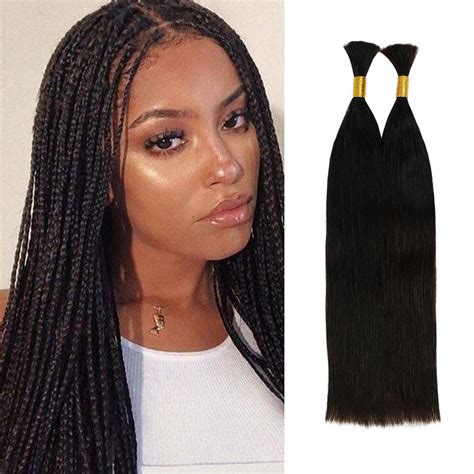Introduction
Human hair braiding weave, also known as hair extension, is a popular technique used to enhance the length, volume, and style of natural hair. It involves braiding artificial or natural hair strands into your natural hair, creating a versatile and customizable look. With various textures and colors available, human hair braiding weaves cater to diverse hair types and preferences.

Market Insights
1. The global hair extension market size was valued at $11.67 billion in 2019 and is projected to reach $18.60 billion by 2027, with a CAGR of 5.7%.
2. The human hair segment accounted for over 50% of the market share in 2019 due to its natural look and feel.
Types of Human Hair Braiding Weaves
1. Clip-In Weaves: Temporary extensions that attach to your natural hair using clips.
2. Tape-In Weaves: Semi-permanent extensions that are attached to your natural hair using adhesive tape.
3. Sew-In Weaves: Long-lasting extensions that are sewn into your natural hair using a needle and thread.
4. Fusion Weaves: Permanent extensions that are attached to your natural hair using a bonding agent.
5. Micro Link Weaves: Semi-permanent extensions that are attached to your natural hair using small beads and loops.
Benefits of Human Hair Braiding Weaves
1. Length and Volume Enhancement: Braiding weaves extend the length and increase the volume of your natural hair, creating a more voluminous look.
2. Color and Style Versatility: Weaves offer a wide range of colors and styles, allowing you to experiment with different looks without damaging your own hair.
3. Protection from Damage: Braiding weaves can protect your natural hair from heat, styling products, and environmental damage.
4. Low Maintenance: Weaves require minimal maintenance compared to other hair extensions, as they can be washed, styled, and brushed like natural hair.
Customization Options
1. Texture: Weaves come in various textures, such as straight, wavy, curly, and kinky, to match your natural hair texture.
2. Color: Weaves can be dyed and toned to match or complement your natural hair color.
3. Length and Density: The length and density of the weave can be customized to achieve your desired look.
Care and Maintenance
1. Wash Regularly: Wash your weaves with shampoo and conditioner specifically designed for extensions.
2. Avoid Excessive Heat: Limit the use of heat styling tools to prevent damage and breakage.
3. Brush Gently: Use a wide-toothed comb or brush to detangle the weave without causing shedding or breakage.
4. Moisturize: Apply hair oil or leave-in conditioner to keep the weave hydrated and prevent dryness.
Troubleshooting Common Issues
1. Shedding: Minimal shedding is normal, but excessive shedding can indicate improper application or care.
2. Tangling: Regular brushing and detangling will help prevent tangles.
3. Itching or Irritation: The adhesive used in some weaves can cause scalp irritation. Use a barrier spray to protect your scalp.
FAQs
1. How long do human hair braiding weaves last?
A. Temporary weaves (clip-in and tape-in) typically last for a few weeks, while semi-permanent (sew-in and micro link) weaves can last for 3-6 months. Permanent weaves (fusion) can last even longer.
2. Can I use my regular hair products with human hair weaves?
A. No, it’s recommended to use hair products specifically formulated for extensions.
3. Can I swim or exercise with human hair weaves?
A. Yes, but take precautions to avoid excessive tangling or damage.
4. How much do human hair braiding weaves cost?
A. The cost varies depending on the type of weave, length, density, and application method.
5. Can I install human hair braiding weaves at home?
A. Installing weaves at home is not recommended. It’s best to consult a professional hair stylist.
6. How often should I get my human hair weave re-installed?
A. Re-installation is typically needed every 4-8 weeks to maintain a flawless look.
